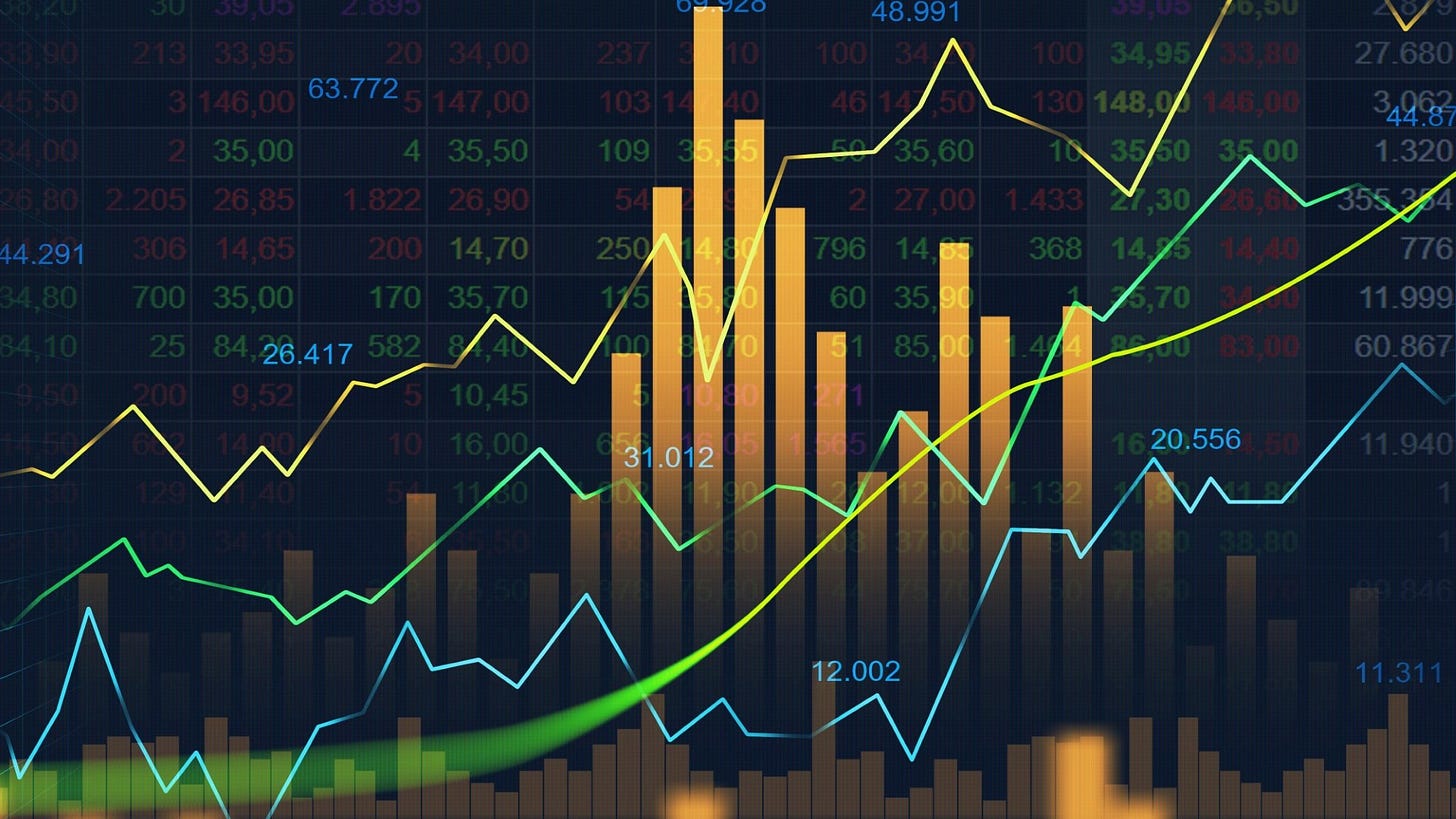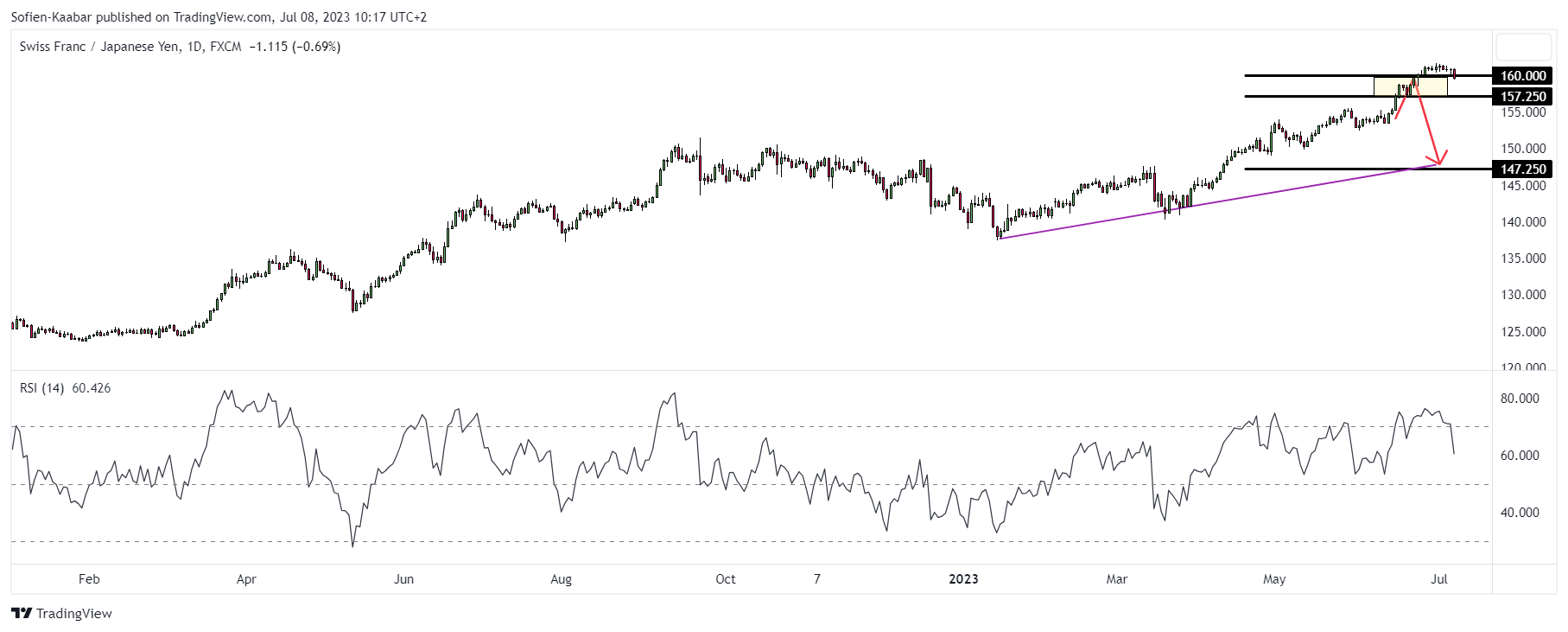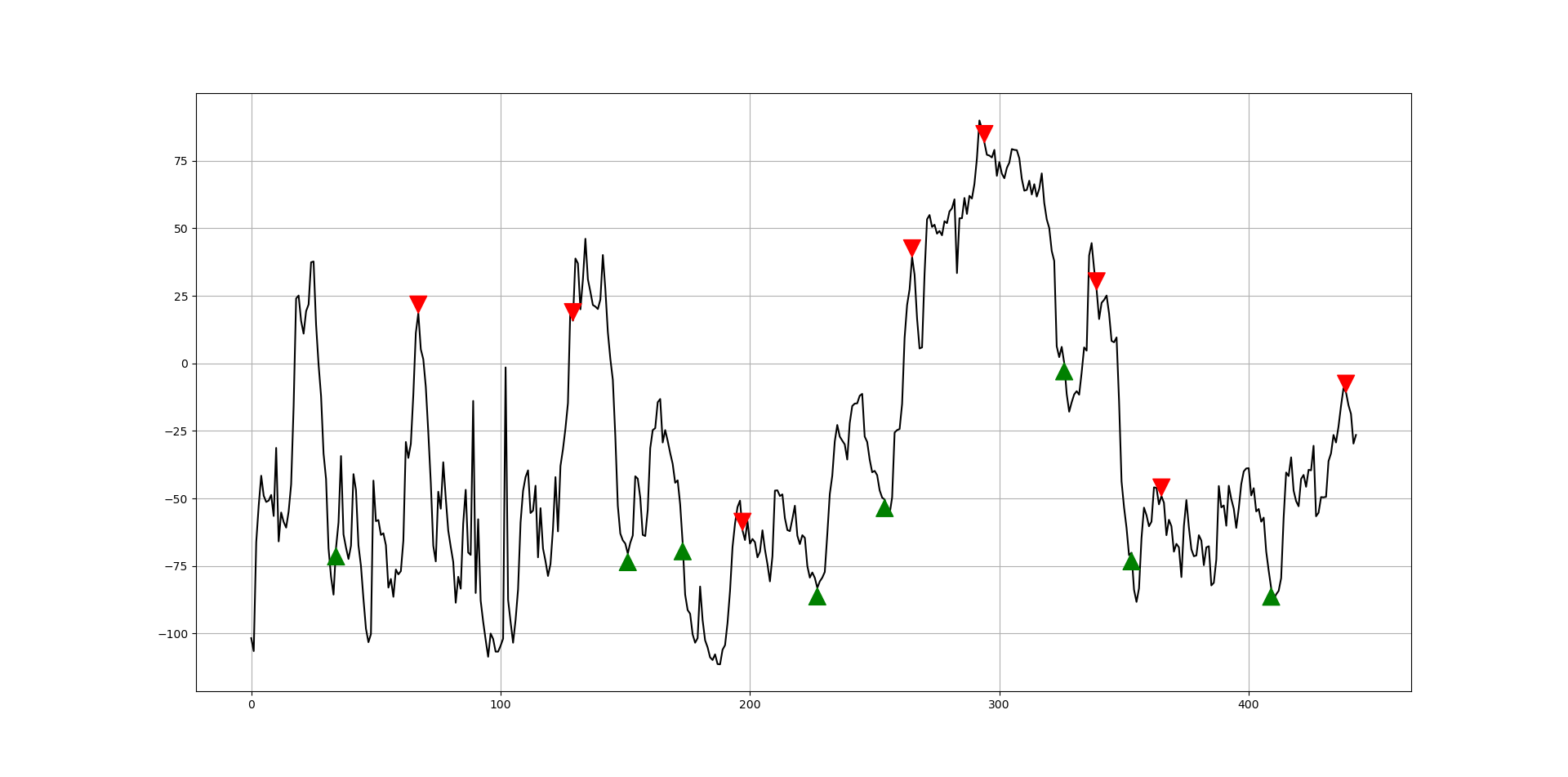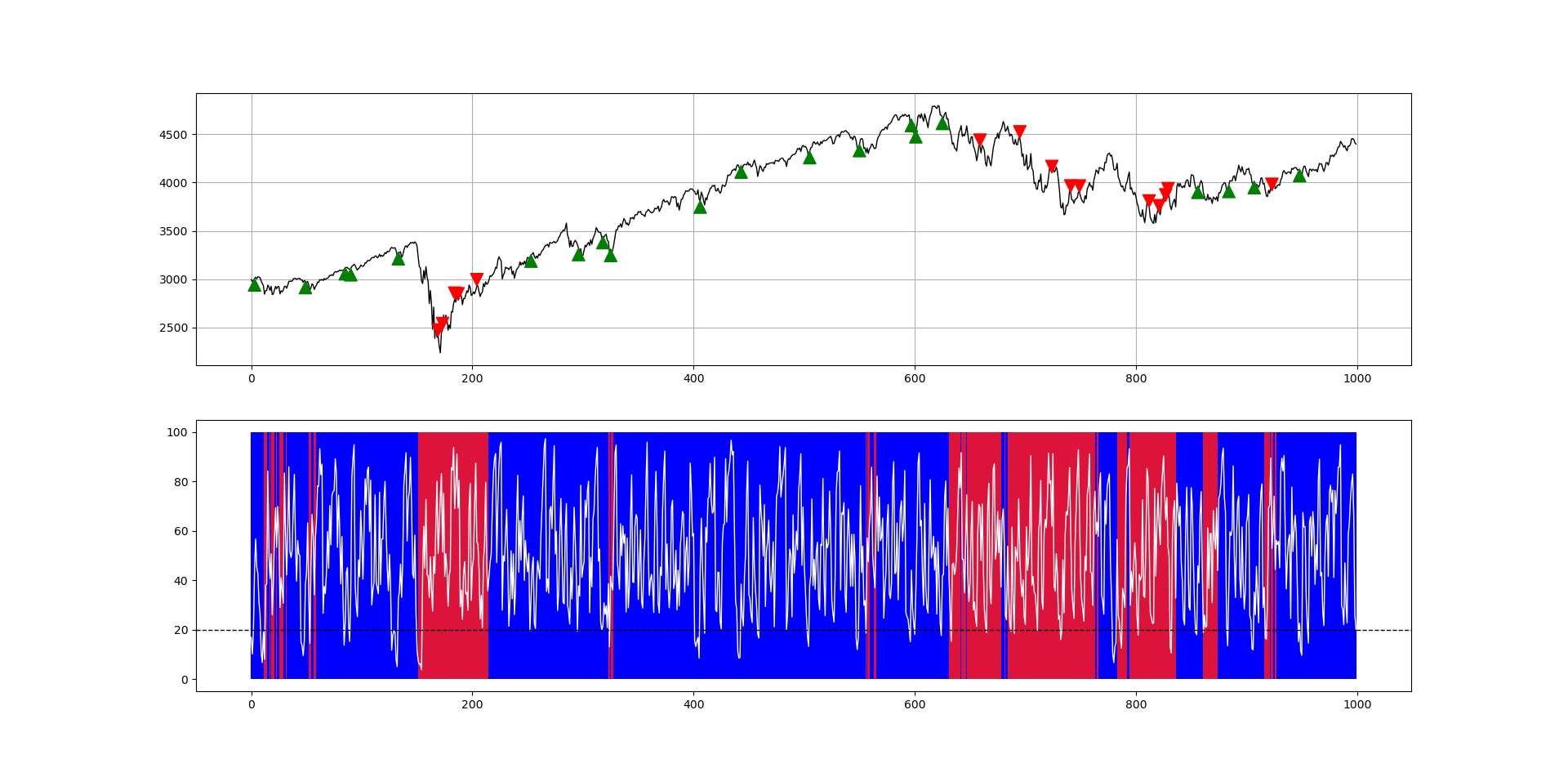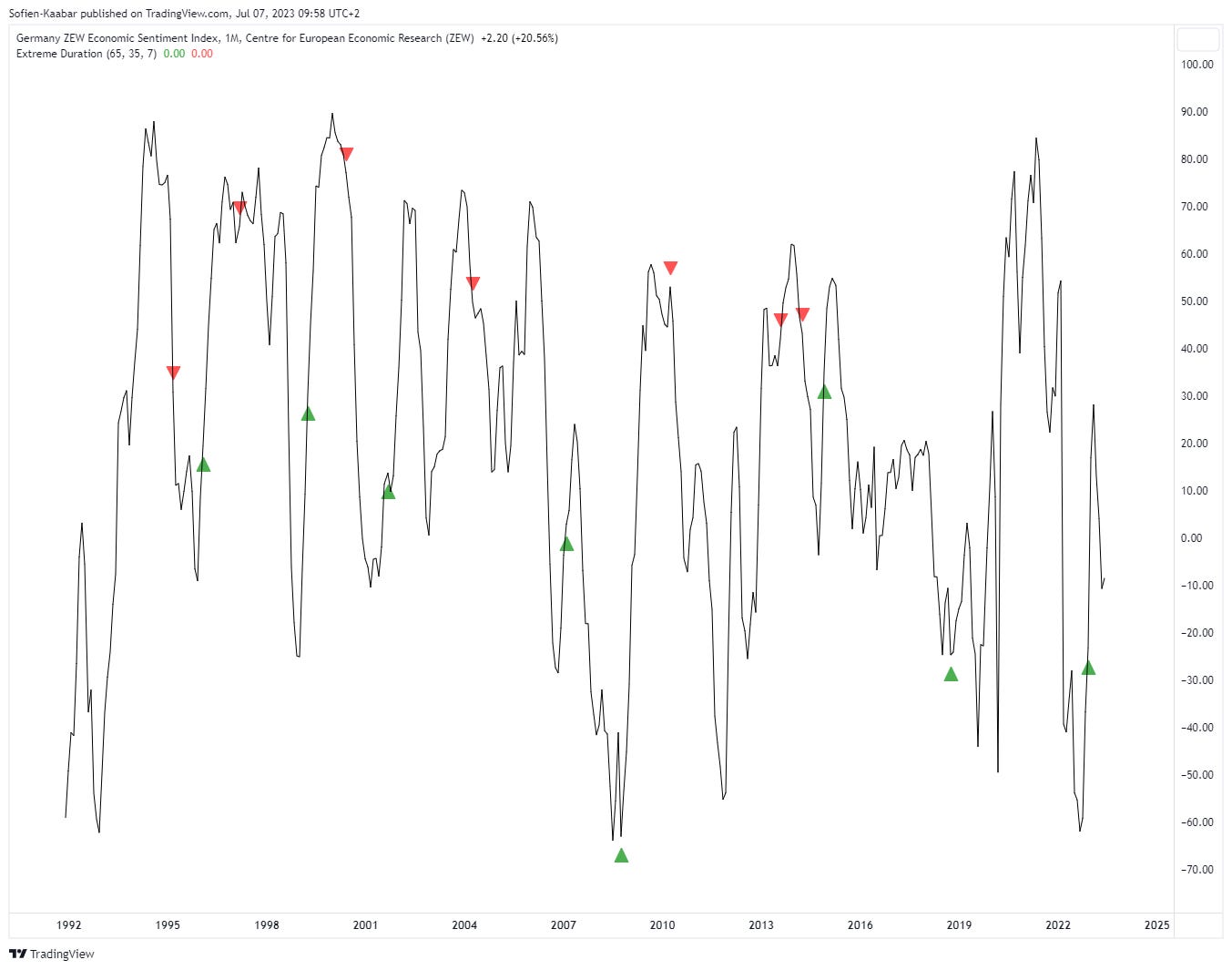The Weekly Market Sentiment Report: 9th July - 16th July 2023
The Weekly Market Sentiment Report: 09/07/2023 - 16/07/2023
CONTENTS
EVOLUTION OF THE REPORT
ECONOMIC CALENDAR
THE COMMITMENT OF TRADERS REPORT: NORMALIZED VALUES
THE COMMITMENT OF TRADERS REPORT: PATTERN RECOGNITION
THE BULLISH SENTIMENT INDEX
RISK REVERSAL
THE PUT-CALL RATIO SENTIMENT
THE GAMMA EXPOSURE INDEX
THE AMERICAN ASSOCIATION OF INDIVIDUAL INVESTORS
GERMANY ZEW ECONOMIC SENTIMENT INDEX
THE ISM PURCHASING MANAGER’S INDEX
THE UNIVERSITY OF MICHIGAN CONSUMER SENTIMENT INDEX
COT SIGNALS TRACK RECORD
DISCLAIMER
EVOLUTION OF THE REPORT
This report will grow in time due to feedback and new techniques put into place. You may notice new markets added or other markets removed. Similarly, new sentiment models may be added or removed. Feel free to leave a feedback (e.g. nature of the document, its usefulness, its time interval, its content, language, etc.).
ECONOMIC CALENDAR
THE COMMITMENT OF TRADERS REPORT: NORMALIZED VALUES
The U.S Commodity Futures Trading Commission (CFTC) publishes statistics of the futures market on a weekly basis called the Commitment of Traders (COT) report. The report has many valuable information inside, namely the number of futures contracts held by market participants (hedge funds, banks, producers of commodities, speculators, etc.). Two main categories have to be distinguished:
Commercial players: They deal in the futures markets for hedging purposes (i.e. to cover their operations or other trading positions). Examples of hedgers include investment banks and agricultural giants. Their positions are negatively correlated with the underlying market.
Non-commercial players: They deal in the futures markets for speculative reasons (i.e. to profit from their positions). Examples of speculators include hedge funds. Their positions are positively correlated with the underlying market.
The COT meter takes the difference between the net non-commercial players and the net commercial players in order to get a final net value which is supposed to be positively correlated to the underlying asset.
For example, if the Canadian Dollar is showing an extreme value of 100, then this means that taking into account the past 26 weeks (6 months), the net market positioning has been overly bullish which could mean that a correction may be likely. The following table summarizes the current state of the markets with the optimal opportunities:
The COT report is also known for its commodities side, and therefore, the following shows a summary of a few key commodities:
The details of the most recent trade opportunities are as follows (followed by the charts). Make sure to remember that theses are no advices whatsoever, they are merely charts on COT signals:
🔁 AUDBRL still showing bullish signals above 3.24/3.15 to 3.56.
🔁 BRLJPY still showing bearish signals below 30.20/31.20 to 27.00.
🔁 CADJPY still showing bearish signals below 110.20/110.80 to 104.75.
✅ NZDCAD Potential seen as it has reached at 0.8300.
❌ CHFJPY Directional view jeopardized on as it challenges 160.00 resistance area.
⚠️ The track record of the COT signals can be found in the end of the report ⚠️
☕Digging Deeper☕
This sub-section discusses additional information about the COT’s normalized strategy:
Bitcoin has finally taken off after being in the extremely bearish sentiment zone (synonymous with an expected bullish reaction). However, since technicals weren’t really that great, the bullish Bitcoin recommendation was not published. Now, the sentiment is rising but still showing more bullish potential.
Platinum’s divergence with its COT report is still going. Currently, there is an extremely bullish sentiment with a falling market which may hint to more weakness to come.
Wheat and Corn are at the moment showing extreme bullish COT readings. A correction is in the making?
S&P500 showing extremely high bullish sentiment. The market has already started correcting from last week’s resistance, but is it enough?
THE COMMITMENT OF TRADERS REPORT: PATTERN RECOGNITION
Pattern recognition is a cognitive process that involves the identification, organization, and interpretation of patterns or regularities in data, information, or sensory stimuli. It is the ability to recognize and extract meaningful information from complex or noisy input by identifying underlying structures or relationships. This model applies a certain pattern on the COT values in order to predict local tops and bottoms.
Every week, the model scans the universe of the COT values applied on a certain number of markets and outputs the market(s) where the pattern is detected. The underlying hypothesis is that the market is heavily correlated with its COT values and therefore:
A bullish pattern on the COT values imply a bullish signal on the market.
A bearish pattern on the COT values imply a bearish signal on the market.
Currently, the bearish pattern signal on CHF COT values is coupled with a bullish pattern signal on AUD COT values which may mean that AUDCHF could be interesting as seen in the below charts:
THE BULLISH PERCENTAGE INDEX
This index simply calculates the percentage of stocks in the S&P 500 that are above their 50-Day, 100-Day, and 200-Day moving average. It represents a sentiment shift if single stocks start breaking or surpassing their respective moving averages. The following are the latest values:
The interpretation of the bullish percentage index is pretty much discretionary, but generally high values (close to 90%-100%) are correlated with corrective phases while low values (close to 10%-0%) are correlated with recovery phases.
RISK REVERSAL
In options trading, a risk reversal is a strategy that involves simultaneously buying a call option and selling a put option with the same expiration date. The options chosen typically have the same strike price, but the call option's premium is higher than the put option's premium.
The risk reversal strategy is employed when an options trader has a bullish outlook on the underlying asset. By buying a call option, the trader benefits from the potential upside movement in the asset's price. However, to offset the cost of the call option, the trader sells a put option, which generates premium income but also exposes them to the risk of downside price movement.
The relationship between risk reversal and market sentiment lies in the interpretation of the strategy's structure. The premium differential between the call and put options reflects the market's perception of potential price movements and investor sentiment.
If the premium of the call option is significantly higher than the put option's premium, it indicates that market participants are more bullish and expect the asset's price to rise. This sentiment is reflected in the higher demand and increased price of the call option relative to the put option. Conversely, if the put option's premium is higher than the call option's premium, it suggests a more bearish sentiment in the market. Traders may be purchasing more put options to protect against potential downside risks, leading to higher demand and increased premiums for the put option relative to the call option.
Overall, risk reversal strategies can provide insights into market sentiment by examining the relative pricing and demand for call and put options. They offer a way to gauge the consensus outlook on an underlying asset and can be used as one of many tools to assess market sentiment and make informed trading decisions. The following is the risk reversal (25-Delta) for a select currencies:
Currently, the values are within normality. A signal will be sent in case something interesting comes up.
THE PUT-CALL RATIO SENTIMENT
The equity put-call ratio published by the CBOE gives insights to the current market stress. Historically, the correlation with the stock market (S&P 500) has been intuitively negative with around -0.40 correlation using the Spearman rank correlation coefficient (with -0.32 correlation given using the Pearson correlation coefficient). Similarly, the maximal information coeffcient (MIC) which measures the degree of non-linear relationship has given 0.20 which suggests there is a relationship between the two time series (whether negative or positive).
The strategy uses a type of mean-reversion technique on the put-call ratio to derive signals.
Conclusion: No signal detected by the model at the moment.
THE GAMMA EXPOSURE INDEX
The Gamma Exposure Index (GEI), a proprietary indicator created by financial analytics firm Squeeze Metrics. A stock's or other financial asset's exposure to fluctuations in the general market or benchmark index, usually the S&P 500, is measured by its GEI. The GEI, to put it simply, assesses how sensitive a stock's returns are to fluctuations in the market.
A stock's returns are thought to be more closely correlated with market movements if the GEI is higher, whereas the opposite is true if the GEI is lower. Squeeze Metrics employs GEI to shed light on a stock's or portfolio's risk profile and point out potential avenues for diversification or risk management. Historically, the GEI is correlated with the S&P 500 (around 0.30 across all three different correlation metrics).
Conclusion: No signal detected by the model at the moment.
THE AMERICAN ASSOCIATION OF INDIVIDUAL INVESTORS
The AAII is an equity-based sentiment indicator published by the American Association of Individual Investors every week. The sentiment strategy combines it with the 200-Day moving average.
Conclusion: No signal detected by the model at the moment.
GERMANY ZEW ECONOMIC SENTIMENT INDEX
The Germany ZEW Economic Sentiment Index is a widely recognized economic indicator that measures the sentiment or expectations of financial experts and analysts regarding the German economy. ZEW stands for "Zentrum für Europäische Wirtschaftsforschung" or the Center for European Economic Research, which is a prominent economic research institute based in Germany.
The ZEW Economic Sentiment Index is calculated by surveying a panel of around 300 financial experts, including analysts and institutional investors, who are asked to provide their outlook on the German economy for the next six months. These experts are asked to evaluate factors such as economic growth prospects, inflation expectations, employment conditions, and other relevant economic indicators.
The index is constructed by taking the percentage of positive responses and subtracting the percentage of negative responses. A positive index value indicates optimism and suggests that economic conditions are expected to improve in the near future, while a negative value indicates pessimism and suggests expectations of worsening economic conditions.
The Germany ZEW Economic Sentiment Index is closely monitored by investors, policymakers, and economists as it provides valuable insights into the sentiment and expectations of market participants. It can have an impact on financial markets, as changes in sentiment can influence investment decisions and market movements.
It's important to note that the ZEW Economic Sentiment Index reflects the opinions of experts and analysts, and it is not a direct measurement of actual economic data or outcomes. Nevertheless, it serves as a valuable leading indicator of economic sentiment in Germany.
The model forecasts the next direction of the index which can be used to trade the direction of EURUSD.
Theoretical expectation: A reaction of 1 month is expected following a signal.
Conclusion: It seems that the model is neutral for the moment. No signal in sight given the current levels. However, it’s worth noting that it’s dipping in the negative territory at the moment.
Bear in mind that the ISM PMI is published on a monthly basis.
THE ISM PMI
The institute for supply management provides a monthly survey called the purchasing manager’s index abbreviated to ISM PMI, which is based on questions asked to 400 representatives of industrial companies about the current and future trend of their different activities. It is composed of 5 components that can also be analyzed individually:
New orders — 30% weight.
Production — 25% weight.
Employment — 20% weight.
Supplier Deliveries — 15% weight.
Inventories — 10% weight.
Typically, we interpret the index as 50 being the neutral state of the economy (neither growing and neither shrinking). A reading above 50 indicates an expansion in manufacturing and a reading below 50 indicates shrinking in manufacturing.
Theoretical expectation: A reaction of 18 months is expected following a signal.
Conclusion: It seems that the model is neutral for the moment after signalling a top in 2021. No signal in sight given the current levels.
Bear in mind that the ISM PMI is published on a monthly basis.
THE UNIVERSITY OF MICHIGAN CONSUMER SENTIMENT INDEX
The University of Michigan Consumer Sentiment Index is a measure of consumer confidence or optimism about the economy, as well as their own financial situation. The index is compiled by the University of Michigan's Survey Research Center and is based on a survey of 500 households conducted each month.
The index is derived from responses to a series of questions regarding consumers' expectations for the economy, inflation, interest rates, employment, and their own financial situation. The responses are scored and weighted, with a higher score indicating greater consumer confidence. The Consumer Sentiment Index is often used to gauge the potential impact of economic policies or events on consumer behavior.
Conclusion: It seems that the sentiment index is showing long-term bullishness according to the historical support area.
COT SIGNALS TRACK RECORD
In this section, the details of the previous discretionary signals (opportunities) found using the COT normalized index technique. Note that this track record is only for illustrative purposes, it is not supposed to attract or sollicit any type of action. It is a bookeeping way of making sure that the COT technique is still delivering value:
DISCLAIMER
Every information contained in the report is solely for the purpose of showing another angle. Since it is NOT investment advice or trade recommendations, you must NOT use the report as the sole reason for your trading and investing activities.
Trading is fun, enriching, and interesting but not when it comes at the expense of your hard-earned funds. Do not risk what you cannot afford to lose. You must only trade with money you have already considered gone and you must not use trading as your sole revenue generator. Risk management is even more important than the trading strategy itself, make sure to master it.
Data can have many representations and the information presented is but one side of the story which may be incomplete. All back-testing and forward testing results reflect their own time period and not the future as is the case in every research piece.




